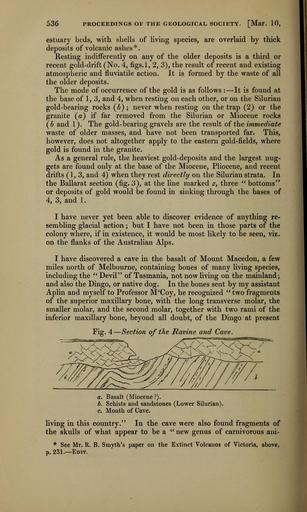MAKE A MEME
View Large Image

| View Original: | The_Quarterly_journal_of_the_Geological_Society_of_London_(12826784024).jpg (1211x2017) | |||
| Download: | Original | Medium | Small | Thumb |
| Courtesy of: | commons.wikimedia.org | More Like This | ||
| Keywords: The Quarterly journal of the Geological Society of London (12826784024).jpg 536 <br> PROCEEDINGS OF THE GEOLOGICAL SOCIETY Mar 10 <br> estuary beds with shells of living species are overlaid by thick <br> deposits of volcanic ashes <br> Resting indifferently on any of the older deposits is a third or <br> recent gold-drift No 4 figs l 2 3 the result of recent and existing <br> atmospheric and fluviatile action It is formed by the waste of all <br> the older deposits <br> The mode of occurrence of the gold is as follows ” It is found at <br> the base of 1 3 and 4 when resting on each other or on the Silurian <br> gold-bearing rocks 6 ; never when resting on the trap 2 or the <br> granite a if far removed from the Silurian or Miocene rocks <br> 6 and 1 The gold-bearing gravels are the result of the immediate <br> waste of older masses and have not been transported far This <br> however does not altogether apply to the eastern gold-fields where <br> gold is found in the granite <br> As a general rule the heaviest gold- deposits and the largest nug- <br> gets are found only at the base of the Miocene Pliocene and recent <br> drifts 1 3 and 4 when they rest directly on the Silurian strata In <br> the Ballarat section fig 3 at the line marked z three bottoms <br> or deposits of gold would be found in sinking through the bases of <br> 4 3 and 1 <br> I have never yet been able to discover evidence of anything re- <br> sembling glacial action ; but I have not been in those parts of the <br> colony where if in existence it would be most likely to be seen viz <br> on the flanks of the Australian Alps <br> I have discovered a cave in the basalt of Mount Macedon a few <br> miles north of Melbourne containing bones of many living species <br> including the Devil of Tasmania not now living on the mainland; <br> and also the Dingo or native dog In the bones sent by my assistant <br> Aplin and myself to Professor M'Coy he recognized two fragments <br> of the superior maxillary bone with the long transverse molar the <br> smaller molar and the second molar together with two rami of the <br> inferior maxillary bone beyond all doubt of the Dingo at present <br> Fig 4 ” Section of the Ravine and Cave <br> a Basalt Miocene <br> b Schists and sandstones Lower Silurian <br> c Mouth of Cave <br> living in this country In the cave were also found fragments of <br> the skulls of what appear to be a new genus of carnivorous ani- <br> See Mr R B Smyth's paper on the Extinct Volcanos of Victoria above <br> p 231 ” Edit 36214526 111684 51125 Page 536 Text v 14 http //www biodiversitylibrary org/page/36214526 1858 Geological Society of London Biodiversity Heritage Library The Quarterly journal of the Geological Society of London v 14 1858 Geology Periodicals Smithsonian Libraries bhl page 36214526 dc identifier http //biodiversitylibrary org/page/36214526 smithsonian libraries Information field Flickr posted date ISOdate 2014-02-28 Check categories 2015 August 26 CC-BY-2 0 BioDivLibrary https //flickr com/photos/61021753 N02/12826784024 2015-08-26 17 54 44 cc-by-2 0 PD-old-70-1923 The Quarterly journal of the Geological Society of London 1858 Photos uploaded from Flickr by Fæ using a script | ||||